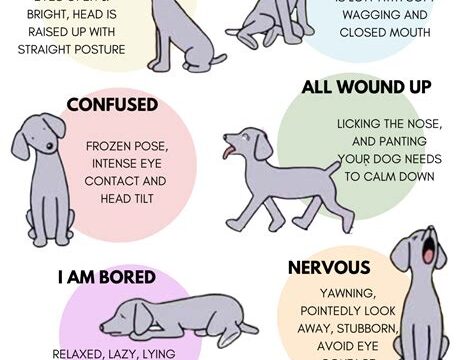As pet owners, understanding our dogs’ body language is essential for building a strong and trusting relationship with them. Our furry friends may not be able to speak to us in words, but they communicate with us through their body movements, facial expressions, and vocalizations. In this comprehensive guide, we will explore the common body language signals that dogs use to convey their emotions and intentions. From interpreting their facial expressions to decoding their tail movements and positions, we will delve into the various ways in which dogs communicate non-verbally. Additionally, we will discuss the different types of barks that dogs use to express themselves, as well as signs of stress, anxiety, fear, and aggression in their body language. By understanding and recognizing these cues, pet owners can better meet their dogs’ needs and ensure a happy and healthy relationship with their beloved pets.
Common dog body language signals
Dogs use body language to communicate with us and with other dogs. Understanding their signals is crucial for building a strong relationship with your pet and for keeping them safe.
One of the most common body language signals is the wagging of the tail. While many people believe that a wagging tail always means a happy dog, this is not always the case. A slow, stiff wag can indicate anxiety or aggression, while a rapid wag with the tail held high can signal excitement or happiness.
Another important signal is the position of the ears. When a dog is relaxed, their ears are usually in a neutral position, but they may tilt them forward when curious or pull them back when fearful. If the ears are flat against the head, the dog may be feeling aggressive or stressed.
Other body language signals to look out for include eye contact, body posture, and facial expressions. By paying attention to these signals, you can better understand your dog’s emotions and respond accordingly.
Interpreting a dog’s facial expressions
Dogs communicate with us and with each other through a variety of facial expressions. Understanding these expressions can help us better interpret our furry friends’ emotions and moods.
One of the most common facial expressions a dog can make is a relaxed and open mouth. When a dog is feeling happy and at ease, they may have their mouth open and their tongue lolling to the side. This is a clear sign of contentment.
On the other hand, if a dog is feeling anxious or fearful, their facial expressions may include things like widened eyes, pulled back ears, and a tense mouth. These are signs that the dog is feeling uncomfortable and may need some space or reassurance.
When a dog is feeling aggressive or threatened, their facial expressions can change dramatically. They may bare their teeth, stiffen their facial muscles, and stare intensely. These are all signs that a dog is feeling threatened and may be preparing to defend themselves.
Decoding tail movements and positions
When it comes to understanding our furry friends, decoding tail movements and positions can provide valuable insight into their emotions and intentions. Dogs use a variety of tail movements and positions to communicate with us and other dogs, so it’s important for pet owners to be able to interpret these signals accurately.
One common tail position that indicates a dog is feeling calm and relaxed is when their tail is held at a natural level. It’s neither too high nor too low, and it often wags gently from side to side. This is the ideal tail position that owners hope to see in their pets, as it signifies contentment and a friendly demeanor.
On the other hand, if a dog’s tail is tucked between their legs, it usually indicates fear or submission. This position is often seen in dogs that are feeling anxious or stressed, and it’s important to approach them gently and reassure them that they are safe. Similarly, a high, stiff tail is often a sign of aggression – the dog may be feeling threatened or defensive, and it’s best to give them space and not approach them directly.
Aside from tail positions, the way a dog’s tail is wagging can also give us important clues about their mood. A broad, sweeping wag often indicates happiness and excitement, while a fast, stiff wag may signal agitation or agitation. By paying attention to tail movements and positions, we can better understand our canine companions and respond to their needs accordingly.
Understanding different types of barks
When it comes to understanding our canine companions, one of the most important aspects to pay attention to is their barks. Dogs use barks to communicate a variety of messages, and being able to interpret these barks can help us better understand their needs and emotions.
One type of bark that dogs commonly use is the alarm bark. This type of bark is sharp and loud, and is often used to alert their human to a potential threat or intruder. It is usually accompanied by a raised tail and a tense body posture.
Another type of bark is the playful bark. This type of bark is higher in pitch and is often accompanied by a wagging tail and an excited body language. Dogs usually use this bark when they are feeling happy and playful, and want to engage in some fun activities with their human or other dogs.
The distress bark is a type of bark that is characterized by a high-pitched and repetitive sound. Dogs use this type of bark when they are feeling scared, anxious or in pain. It is important to pay attention to this type of bark and provide comfort and reassurance to the dog.
Signs of stress and anxiety in dogs
Recognizing the signs of stress and anxiety in dogs is important for any pet owner. Dogs can experience stress and anxiety for a variety of reasons, and it’s crucial to be able to identify when our furry friends are feeling overwhelmed. One common sign of stress in dogs is excessive panting, drooling, or shaking. If you notice your dog exhibiting these behaviors, it may be a sign that they are feeling anxious or stressed.
Another indicator of stress and anxiety in dogs is changes in behavior. If your dog suddenly starts to display destructive behaviors, such as chewing on furniture or excessive barking, it could be a sign that they are feeling stressed. Additionally, some dogs may become withdrawn or show signs of aggression when they are feeling anxious.
Physical symptoms such as dilated pupils, rapid breathing, or a tucked tail can also be signs of stress and anxiety in dogs. It’s important to pay attention to these physical cues and seek help from a veterinarian or professional dog trainer if you notice any of these symptoms in your pet.
Overall, being able to recognize the signs of stress and anxiety in dogs is crucial for providing them with the care and support they need. By understanding and addressing your dog’s emotional well-being, you can help them lead a happy and healthy life.
Reading your dog’s body posture
When it comes to understanding your dog’s emotions and intentions, paying attention to their body posture is crucial. Body posture is the position and carriage of the body as a whole, and it can convey a lot of information about how a dog is feeling in a given moment.
One of the most common body postures that dogs display is the play bow. When a dog lowers their front end while keeping their rear end up, it’s a clear signal that they are in a playful and friendly mood. This posture is often accompanied by wagging tails and bouncing movements.
On the other hand, a dog that is feeling anxious or fearful may exhibit a lowered body posture. They might hunch their body, tuck their tail between their legs, and lower their head. This is a clear indication that the dog is feeling stressed and uncomfortable in their current environment.
Another important body posture to take note of is a stiff and upright stance. When a dog stands with their body tense and rigid, it often indicates that they are feeling alert, cautious, or even aggressive. This is a clear sign that the dog is ready to react to any perceived threat.
Interpreting ear positions and movements
Interpreting a dog’s ear positions and movements can provide valuable insights into their emotions and intentions. Dogs use their ears to communicate a wide range of signals, and understanding these cues can help us better connect with our canine companions.
One common ear position that indicates a relaxed and content state is when a dog’s ears are in their natural position and facing forward. This often signifies that the dog is feeling at ease and comfortable in their environment.
On the other hand, ears that are pinned back against the head can be a sign of fear or aggression. When a dog feels threatened or anxious, they may flatten their ears against their head to protect themselves or to signal their discomfort.
Additionally, dogs may also tilt or perk up their ears when they are curious or trying to focus their attention on something. This can indicate that they are actively listening and processing the sounds around them.
Recognizing signs of fear or aggression
Recognizing signs of fear or aggression in dogs is essential for understanding their behavior and ensuring their well-being. One of the most obvious signs of fear in a dog is cowering or trembling. When a dog is afraid, they may tuck their tail between their legs and lower their body to the ground. They may also exhibit submissive behavior such as avoiding eye contact, licking their lips, or flattening their ears against their head.
In addition to cowering and submissive behavior, a fearful dog may display agitated body language, such as pacing, panting, or yawning. They may also exhibit signs of aggression, such as growling, snarling, or baring their teeth. It’s important to recognize these signals and respond appropriately to prevent an escalation of fear or aggression.
When a dog is exhibiting signs of fear or aggression, it’s important to remain calm and avoid making sudden movements or loud noises that could further agitate them. Instead, give the dog space and allow them to move away from the source of their fear. If the dog is displaying signs of aggression, it’s crucial to remove yourself and others from the situation to avoid potential harm.
By recognizing and understanding the signs of fear and aggression in dogs, you can better address their needs and create a safe and supportive environment for them to thrive in.





